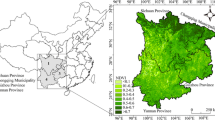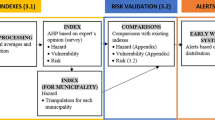Abstract
Drought is one of the most critical meteorological hazards that has a devastating effect on natural habitats, ecosystems, and many economic and social sectors. Due to these severe impacts of drought events, many studies have focused on drought monitoring, prediction, and risk analysis to aid drought preparedness plans and mitigation measures. This paper presents a new drought composite index (DCI) to measure the intensity and frequency of the hazard component of meteorological drought. The DCI considers multiple indicators, such as precipitation, temperature, evapotranspiration, wind speed, relative humidity, and sunshine duration. The DCI is validated through an application to the Brazilian semiarid context. Based on the expert's opinion, we define the weight of each indicator using the analytical hierarchy process. The results were compared with two other drought indices to provide an initial validation because the other indices are not exclusively meteorological indices. The DCI estimates for January 2019 show that the semiarid central region is the most critical. The findings also indicate that the drought intensity is growing in this region.




Source: Adapted from SUDENE (2019)



Source: Adapted from CEMADEN (2019)

Source: Adapted from northeast drought monitor (2019)
Similar content being viewed by others
References
Alvalá RCS, Cunha APMA, Brito SSB, Seluchi ME, Marengo JÁ, Moraes LL, Carmvalho MA (2017) Drought monitoring in the Brazilian semiarid region. Acad Bras de Cienc. https://doi.org/10.1590/0001-3765201720170209
Anderson LO, Ribeiro Neto G, Cunha APMA, Fonseca MG, Mendes de Moura Y, Delagnol R, Wagner FH, De Aragão LEO (2018) Vulnerability of amazonian forests to repeated droughts. Phil Trans R Soc B-Biol Sci 373:20170411
Bravo RZB, Leiras A, Cyrino FLO (2019) The use of UAVs in humanitarian relief: an application of POMDP-based methodology for finding victims. Prod Oper Manag 28:421–440
Brito SSB, Cunha APMA, Castro CC, Alvalá RCS, Marengo JA, Carvalho M (2018) Frequency duration and severity of drought in the Brazilian semiarid. Int J Climatol. https://doi.org/10.1002/joc.5225.2018
CEMADEN (2019) Sistema de Monitoramento de Seca para o Brasil – Janeiro/2019. http://www.cemaden.gov.br/sistema-de-monitoramento-de-seca-para-o-brasil-janeiro2019-2/. Accessed 29 May 2019
Cheng J, Tao JP (2010) Fuzzy comprehensive evaluation of drought vulnerability based on the analytic hierarchy process: an empirical study from Xiaogan City in Hubei province. Agric Agric Sci Procedia 1:126–135
Cunha APMA, Alvalá RCS, Nobre CA, Carvalho MA (2015) Monitoring vegetative drought dynamics in the Brazilian semiarid region. Agric Meteorol 214–215:494–505
Cunha AP, Marchezini V, Lindoso D, Saito S, Alvará RC (2019a) The challenges of consolidation of a drought-related disaster risk warning system to Brazil. Sus Deb 10:43–76
Cunha AP, Alvalá RCS, Cuartas AL, Orsini JAM, Marchezini V, Saito SMS, Munoz V, Leal KRD, Ribeiro-Neto G, Seluchi ME, Zeri LMM, Castro CAC, Costa LCO, Zhang R, Moraes OLL (2019b) Brazilian experience on the development of drought monitoring and impact assessment systems. contributing paper to GAR 2019
Cunha APMA, Zeri M, Deusdará Leal K, Costa L, Cuartas LA, Marengo JA, Tomasella J, Vieira RM, Barbosa AA, Cunningham C, Cal Garcia JV, Broedel E, Alvalá R, Ribeiro-Neto G (2019) Extreme drought events over Brazil from 2011 to 2019c. Atmosphere 10:642
Eckhardt D, Leiras A, Thomé AMT (2019) Systematic literature review of methodologies for assessing the costs of disasters. Int J Disaster Risk Reduct 33:398–416
Fang D, Hu Z, Wang Z, Duan G (2011) Drought disaster risk assessment and mapping at different scales based on RS and GIS. In: 19th International Conference on Geoinformatics https://doi.org/10.1109/GeoInformatics.2011.5980770
Fontaine MM, Steinemann AC (2009) Assessing vulnerability to natural hazards: Impact-based method and application to drought in Washington state. Nat Hazard Rev 10(1):11–18
GreyNet (2019) GreyNet International 2019. http://www.greynet.org/. Accessed 11 May 2019
Guo E, Liu X, Zhang J, Wang Y, Wang C, Wang R, Li D (2017) Assessing spatiotemporal variation of drought and its impact on maize yield in northeast China. J Hydrol 553:231–247
Hao Z, Hao F, Singh VP, Ouyang W, Cheng H (2017) An integrated package for drought monitoring, prediction and analysis to aid drought modeling and assessment. Environ Model Softw 91:199–209
Hayes MJ, Wilhelmi OV, Knutson CL (2004) Reducing drought risk: bridging theory and practice. Nat Hazard Rev 5(2):106–113
Hoque M, Pradhan B, Ahmed N (2020) Assessing drought vulnerability using geospatial techniques in northwestern part of Bangladesh. Sci Total Environ 705:135957
Huang L, Yang P, Ren S (2014) The vulnerability assessment method for Beijing agricultural drought. In: Li D, Chen Y (eds) IFIP advances in information and communication technology. Springer, Berlin
Huang L, Yang P, Ren S (2014) Brief probe into the key factors that influence Beijing agricultural drought vulnerability. In: Li D, Chen Y (eds) IFIP advances in information and communication technology. Springer, Berlin
INMET (2019) BDMEP. http://www.inmet.gov.br/portal/index.php?r=bdmep/bdmep. Accessed 29 April 2019
Jia H, Wang J, Cao C, Pan D, Shi P (2012) Maize drought disaster risk assessment of China based on EPIC model. Int J Digit Earth 5(6):488–515
Jiang S, Yang R, Cui N, Zhao L, Liang C (2018) Analysis of drought vulnerability characteristics and risk assessment based on information distribution and diffusion in southwest China. Atmosphere 9(7):239
Karamouz M, Zeynolabedin A, Olyaei MA (2015) Mapping regional drought vulnerability: a case study. Int Arch Photogramme Remote Sens Spatial Inf Sci 40:369–377
Kuswanto H, Fithriasari K, Inas R (2018) Drought risk mapping in east Nusa Tenggara Indonesia based on return periods. Asian J Sci Res 11(4):489–497
Li Y, Gu W, Cui W, Chang Z, Xu Y (2015) Exploration of copula function use in crop meteorological drought risk analysis: a case study of winter wheat in Beijing, China. Nat Hazards 77:1289–1303
Martins E, De Nys E, Silva RFV, Engle NL (2015) Monitor de Secas do Nordeste, em busca de um novo paradigma para a gestão de secas. https://doi.org/10.13140/RG.2.1.4238.8886
De Melo PO, De Britto RM, Fontainha TC, Leiras A, Bandeira RAM (2017) Evaluation of community leaders’ perception regarding Alerta Rio, the warning system for landslides caused by heavy rains in Rio de Janeiro. Nat Hazards 89:1343–1368
Mongeon P, Paul-Haus A (2016) The journal coverage of Web of science and scopus: a comparative analysis. Scientometrics 106:213–228
Murthy CS, Singh J, Kumar P, Sesha Sai MVR (2017) A composite index for drought hazard assessment using CPC rainfall time series data. Int J Environ Sci Technol 14(9):1981–1988
Nam WH, Hayes MJ, Svoboda MD, Tadesse T, Wilhite DA (2015) Drought hazard assessment in the context of climate change for South Korea. Agric Water Manag 160:106–117
Neri C, Magaña V (2016) Estimation of vulnerability and risk to meteorological drought in Mexico. Weather Clim Soc 8(2):95–110
Northeast Drought Monitor (2019) Monitor de Secas. http://monitordesecas.ana.gov.br/. Accessed 29 May 2019
Olivares B, Cortez A, Lobo D, Parra R, Rey J, Rodríguez M (2017) Evaluation of agricultural vulnerability to drought weather in different locations of Venezuela. Revista de la Fac de Agron 34(1):103–129
Ortega-Gaucin D, López Pérez M, Arreguín Cortés FI (2016) Drought risk management in Mexico: progress and challenges. Int J Saf Secur Eng 6(2):161–170
Palchaudhuri M, Biswas S (2016) Application of AHP with GIS in drought risk assessment for Puruliya district, India. Nat Hazards 84(3):1905–1920
Saaty TL (1977) A scaling method for priorities in hierarchical structures. J Math Psychol 15(3):234–281
Saaty TL (1987) The analytic hierarchy process: what it is and how it is used. Mathl Modelling 9(3):161–176
Shahid S, Behrawan H (2008) Drought risk assessment in the western part of Bangladesh. Nat Hazards 46(3):391–413
SPEI (2019) The standardised precipitation-evapotranspiration index. http://spei.csic.es/index.html. Accessed 1 May 2019
SUDENE (2019) Delimitação do Semiárido. http://www.sudene.gov.br/delimitacao-do-semiarido. Accessed 29 April 2019
Thomé AMT, Scarvada LF, Scarvada A (2016) Conducting systematic literature review in operations management. Prod Plan Control 27(5):408–420
Thomé AMT, Scarvada A, Ceryno PS, Remmen A (2016) Sustainable new product development: a longitudinal review. Clean Techn Environ Policy 18:2195–2208
UNISDR (2009) Drought risk reduction framework and practices: contributing to the implementation of the Hyogo framework for action. United nations secretariat of the international strategy for disaster reduction. UNISDR, Geneva
Wang J, Meng Y (2013) An analysis of the drought in Yunnan China from a perspective of society drought severity. Nat Hazards 67(2):431–458
Wang Y, Zhao W, Zhang Q, Yao YB (2019) Characteristics of drought vulnerability for maize in the eastern part of Northwest China. Sci Rep 9(1):964
Widianta MMD, Rizaldi T, Setyohadi DPS, Riskiawan HY (2017) Comparison of multi-criteria decision support methods (AHP, TOPSIS, SAW & PROMENTHEE) for employee llacement. In: The 2nd International Joint Conference on Science and Technology (IJCST) 953(2018):012116
Wilhite A (2000) Drought as a Natural Hazard: concepts and definitions. Drought Glob Assess 1(1):3–18
Wilhite A (2000) Drought planning and risk assessment: status and future directions. Ann Arid Zone 39(3):211–230
Wilhite A (2016) Managing drought risk in a changing climate. Clim Res 70(43161):99–102
World Meteorological Organization (WMO) (2016) Handbook of Drought Indicators and Indices, Integrated Drought Management Programme (IDMP), Integrated Drought Management Tools and Guidelines Series 2. Geneva
Wu Y, Bake B, Zhang J, Rasulov H (2015) Spatio-temporal patterns of drought in north Xinjiang, China, 1961–2012 based on meteorological drought index. J Arid Land 7(4):527–543
Wu JS, Lin X, Wang MJ, Peng J, Tu YJ (2017) Assessing agricultural drought vulnerability by a VSD Model: a case study in Yunnan province. China Sustain 9(6):918
Yanbin L, Tiantian D, Feng Y (2016) Risk analysis on agricultural drought disaster in Henan province. Int J Earth Sci Eng 9(4):16951699
Ye T, Shi P, Wang J, Liu L, Fan Y, Hu J (2012) China’s drought disaster risk management: perspective of severe droughts in 2009–2010. Int J Disaster Risk Sci 3(2):84–97
Zeri M, Alvalá RS, Carneiro R, Cunha-Zeri G, Costa J, Spatafora LR, Domingos U, Vall-Llossera M, Marengo J (2018) Tools for communicating agricultural drought over the Brazilian semiarid using the soil moisture index. Water 10:1421
Zhang DD, Yan DH, Lu F, Wang YC, Feng J (2014) Copula-based risk assessment of drought in Yunnan province. China Nat Hazards 75(3):2199–2220
Zhou GY, Peng CH, Li YL, Liu S, Zhang Q, Tang X, Liu J, Yan J, Zhang D, Chu G (2013) A climate change-induced threat to the ecological resilience of a subtropical monsoon evergreen broadleaved forest in south China. Glob Change Biol 19:1197–1210
Zhou L, Wu J, Zhang J, Leng S, Liu M, Zhao L, Zhang F, Shi Y (2013) The integrated surface drought index (ISDI) as an indicator for agricultural drought monitoring: theory validation and application in mid-eastern China. IEEE J Sel Top Appl Earth Obs Remote Sens 6:1254–1262
Acknowledgements
The authors acknowledge the support of Conselho Nacional de Desenvolvimento Científico e Tecnológico [Grant Numbers 465501/2014-1; 308084/2019-5; 307403/2019-0], Fundação Carlos Chagas Filho de Amparo à Pesquisa do Estado do Rio de Janeiro [Grant Numbers 203178/2016; 202673/2018; 211086/2019], and Fundação de Amparo à Pesquisa do Estado de São Paulo [Grant Number 2014/50848-9]. Moreover, this study was financed in part by the Coordenação de Aperfeiçoamento de Pessoal de Nível Superior—Brasil (CAPES)—Finance Code 001 [Grant Numbers 88887.091739/2014-01; 88887.136402/2017-00].
Author information
Authors and Affiliations
Corresponding author
Ethics declarations
Conflict of interest
The authors have no conflicts of interest to declare that are relevant to the content of this paper.
Additional information
Publisher's Note
Springer Nature remains neutral with regard to jurisdictional claims in published maps and institutional affiliations.
Appendix: specialist's country
Rights and permissions
About this article
Cite this article
Bravo, R.Z.B., Cunha, A.P.M.d., Leiras, A. et al. A new approach for a drought composite index. Nat Hazards 108, 755–773 (2021). https://doi.org/10.1007/s11069-021-04704-x
Received:
Accepted:
Published:
Issue Date:
DOI: https://doi.org/10.1007/s11069-021-04704-x





